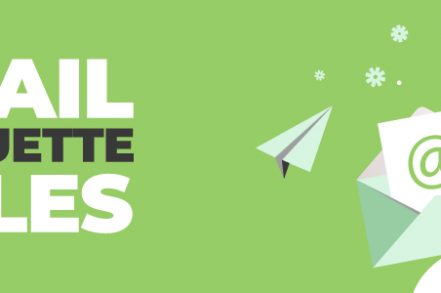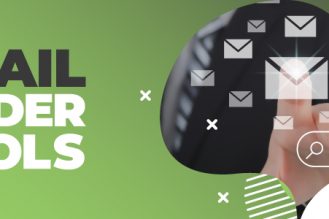For better or for worse, the email inbox dominates our workdays. It’s estimated that over 120 emails are received each day in the average American worker’s inbox. That’s a lot of time spent reading, writing, and responding to emails, so it should go without saying that putting your best foot forward is a must.
What is Email Etiquette?
Email etiquette spans a wide variety of strategies, principles, and tactics. But at a high level, it encompasses the guiding behavioral rules of how one should send and reply to email messages.
In short, email etiquette teaches you how to be polite and effective when communicating via email. It can apply to both personal and professional engagements.
Why is Email Etiquette Important?
There are a number of reasons why email etiquette is important to know, some of which include:
- Professionalism: while much of today’s work culture has shifted to an informal style, it is still important to make a good impression on colleagues, clients, and business partners.
- Efficiency: great email etiquette is efficient. It not only saves you time, but also that of your recipient. That way, everyone can spend more time doing what they truly want.
- Longevity: just because you win a client or customer, doesn’t mean you will retain them. Having appropriate communications helps ensure that you retain your revenue-generating relationships over a longer period.
Professional Email Etiquette Rules
Every professional should know the basics of email etiquette. If you commit these 35 rules to memory, you’ll be sure to stand out in the inbox for all the right reasons in 2024
1. Use a Professional Email Address
If you don’t have a company email address, your personal email address should look the part of a professional. Best practice is to use your name as your email address so your recipients will know immediately who it’s coming from. Check out these 40 ideas for creating a professional email address.
2. Include a Clear, Direct Subject Line
Forty-seven percent of people decide whether to open an email based solely on the subject line. Keep it clear and succinct so your message is more likely to be read.
3. Build Your Signature Block
Email signature blocks usually contain your name, company, job title, and additional contact information (e.g. website, phone number, etc.). This helps your recipient get to know more about you, and adds credibility to your message.
4. Don’t Automatically Hit “Reply All”
Think carefully: does everyone in the email thread need to hear your thoughts, or just the sender? There may be times when hitting “Reply All” makes sense, but don’t let it become a thoughtless habit.
5. Proofread Your Messages
Having misspellings and errors in your messages isn’t just unprofessional – your recipient may also judge you for it. Read your message out loud to catch potential errors before you send it. You can also use proofreading tools like Grammarly to highlight issues.
6. Keep It Professional
It’s not a good idea to get too personal in an email. Opt for a professional yet friendly tone so there are no questions about your intentions.
7. Write Like Everyone Will Read It
Emails aren’t as private as you might like to believe. It’s a good idea to write with the idea that more people than the recipient will see it to avoid including anything too personal or sensitive.
8. Using Humor? Proceed With Caution
It’s easy for humor to get lost in translation, especially if you don’t know your recipient very well. What might be funny to you could be taken the wrong way by someone else. It’s best to avoid humor altogether unless you know the person very well and can anticipate their reaction.
9. Use Correct Punctuation
Email isn’t texting. Even when writing an informal email, you should write in sentence case with correct punctuation. This helps you present a professional and polished image.
10. Respond in a Timely Manner
Most people expect a response to an email within a business day (or less). Don’t put off a response, especially if it only requires a short reply. Otherwise, you risk forgetting to respond altogether.
11. Leave an Out-of-Office Reply
If you’re going on vacation or will otherwise be out of the office, set an appropriate auto-reply so your recipients aren’t left in the dark. If they won’t be getting a response from you for a few days, they deserve to know why. Plus, it can prevent them from sending additional follow-up emails that will end up cluttering your inbox.
12. Don’t Send an Email When You’re Angry
It’s easy to go off on a rant when you’re fuming about a mistake or a customer refuses to pay an invoice. Those feelings can often come out in your writing, so make sure you wait until you’ve calmed down before responding. Sharing your feelings of ill will via email can make the situation worse and isn’t productive for either party.
13. Make Friends With BCC
The BCC feature hides the email addresses of other recipients and is often used to protect their privacy. This allows you to email groups en masse without exposing everyone’s email address. It’s also helpful if you don’t want to include someone on the entire inbox thread.
14. Keep It Brief
Given that so many hours of the workweek are spent on email activities, keep your messages as short as possible to respect your recipients’ time.
15. Add a Clear Call to Action, If Necessary
Make sure you let your recipient know what you want them to do. Do you expect a reply? Will you follow up with them? Should they reach out to you if they have any questions? Make it easy for them to comply by specifying what comes next.
16. Make Your Message Easy to Scan
Formatting can have a lot to do with how your message is received. Opt for short paragraphs and bulleted or numbered lists to make your content easier to scan and comprehend.
17. Use Bold Instead of All Caps
If you need to emphasize something in your message, opt for bold instead of all caps. Capitalizing entire words or sentences can come across as yelling and doesn’t do your professional image any favors.
18. Attach PDFs When Possible
To avoid potential compatibility issues, it’s helpful to send files as PDFs when possible. PDF files can be opened on any operating system, whereas Word documents may pose issues.
19. Attach the File First
If you’re sending attachments, attach them first so you don’t forget. It’s also a good idea to call attention to the attachments somewhere in the body of the email.
20. Add the Recipient Last
Saving the “To” field for last ensures you don’t accidentally send a message that isn’t quite ready.
21. Give Your Recipient Time to Respond
Don’t stress if your contact doesn’t respond immediately. You can use an email app like Right Inbox to see if your recipient has opened your email yet. If they have, wait a day or so (if it’s not urgent) before replying. They might still be thinking about their reply.
22. Use the Right Salutation
If you’re responding to an ongoing thread with your colleagues, then a simple “Hi” or even no salutation can suffice. However, if it’s a new contact or prospect, it’s best to err on the side of professionalism and include a greeting.
23. Add Context When Necessary
If someone is joining in on your email conversation, don’t assume they understand certain terms or context. For instance, instead of “John told me we need this done by Thursday,” explain further. “John told me we need the new promo poster graphics done by Thursday.”
24. Know If Email is the Right Medium
Before sending an email, ask yourself if it’s the right channel in the first place. If your recipient hasn’t specified, then email is a safe bet. But if they have communicated that they only want to communicate via another platform, respect their wishes.
25. Try to Limit New Email Threads
People are dealing with enough inbox overwhelm as it is. The last thing they need is a dozen new threads dealing with one project or issue. Use the reply button instead of composing a new email thread when possible.
26. Use Standard Text and Formats
It’s best to avoid reinventing the wheel. You don’t want jarring text colors, sizes, or formats to distract from your message. Stick to standard formatting.
27. Reply to Every Email
Sometimes, an email might not really need a response. However, it’s best to respond anyway. Even a quick “got it” or “thanks” is enough. It lets the sender know you’ve received and understood their message.
28. Keep Emails Within Normal Work Hours
You want to set the right expectations . Aim to send your emails within normal working hours according to your recipient’s time zone. That way, they’re more able to give your email their full attention.
29. Understand Cultural Differences
Take different cultural nuances into account when creating your emails. What is considered polite, professional, friendly, or rude varies from culture to culture. So if you have international contacts, do a few minutes learning their etiquette.
30. Avoid GIFs
Animated images such as GIFs should be avoided in emails. Firstly, they are unprofessional. Secondly, many email providers won’t display the GIF properly, which could affect formatting and readability.
31. Avoid Invasive Questions
Building rapport with your email recipients is all well and good. But avoid prying into their personal lives with questions about family, health, finances or anything in that vein. While you might have good intentions, it can come across as invasive.
32. Respect Time Boundaries
Avoid the temptation to send requests at the last minute. The same goes for expecting a reply during unreasonable time frames — such as over the weekend. It’s fine to send an email on Saturday afternoon, but don’t expect a reply until Monday.
33. Ask Permission Before Sharing Their Email Address
Perhaps you want to loop a colleague in on your conversation. Or you believe you can foster a fruitful connection between two people. Proper etiquette is to ask for both parties’ permission, just as a show of respect.
34. Use Their Preferred Title
There are doctors who communicate informally and prefer just to go by their first names. And there are junior salespeople who prefer to be addressed by Mrs., Mr., or another title. To avoid friction, use the title — or lack thereof — your recipient prefers.
35. Avoid Irrelevant Emails
This rule has to do with respecting your recipient’s digital cleanliness. With so many emails hitting their inbox already, you don’t want to add to the clutter. So if you and your recipient both love the New York Yankees baseball team, that’s great. But include a quick P.S. in your next email to mention the latest game, instead of creating a whole new email.
Track emails, email reminders & templates in Gmail for free
Upgrade Gmail with the features it’s missing
Add to GmailDavid Campbell
David Campbell is the editor of the Right Inbox blog. He is passionate about email productivity and getting more done in less time.




